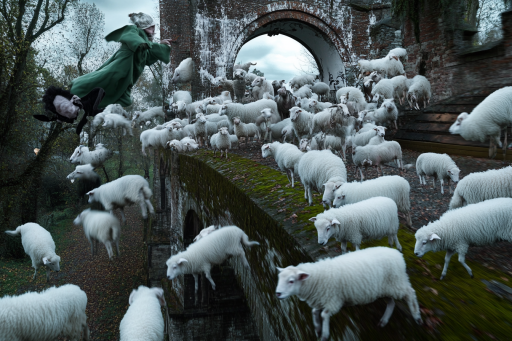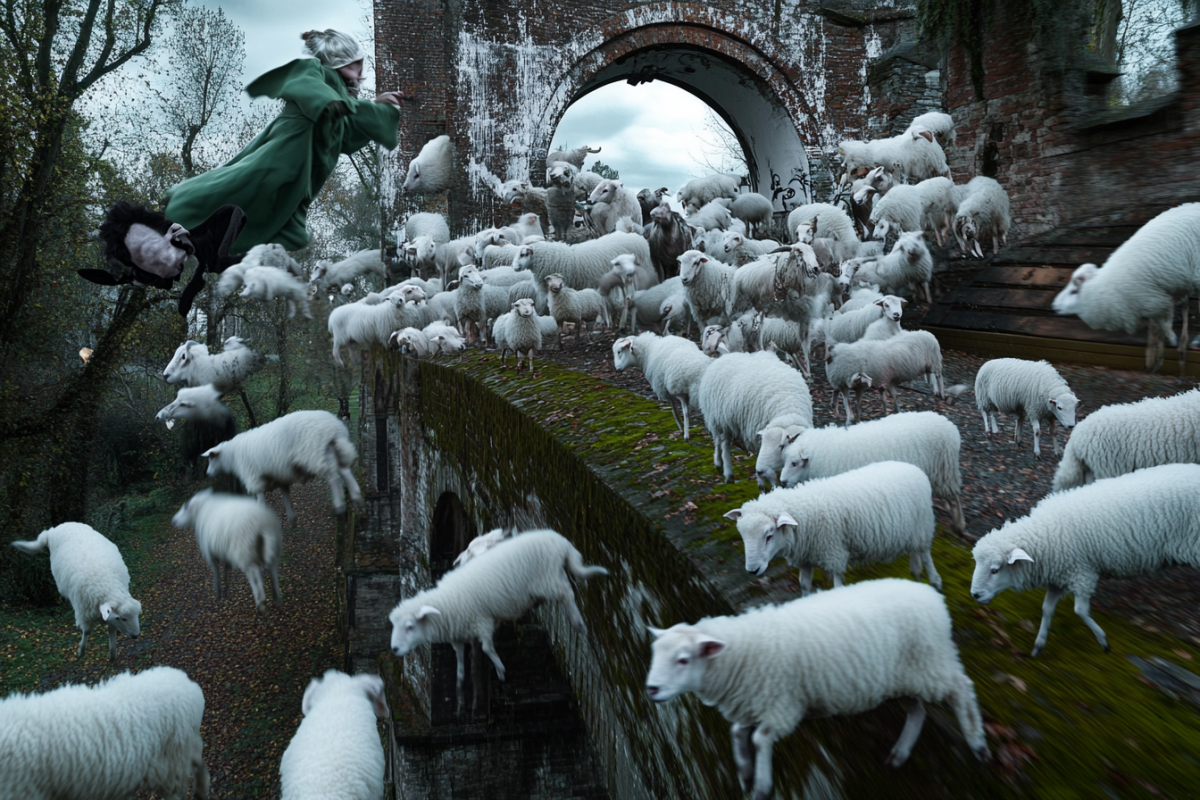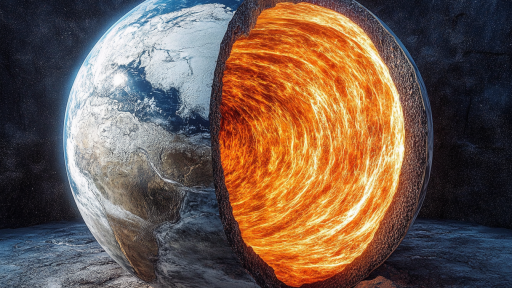
Animals have long been known for their instincts, intelligence, and survival skills, but sometimes their behavior defies logic. From mysterious mass movements to animals displaying human-like problem-solving skills, nature is full of surprises. Scientists have attempted to explain many of these oddities, but some behaviors remain completely baffling. Whether these animals are sensing something humans can’t, reacting to invisible forces, or simply rewriting the rules of biology, their unexplainable actions challenge everything we think we know about the natural world.
The Sheep That Walked in a Perfect Circle for Days

In 2022, a bizarre video surfaced from China showing a large flock of sheep walking in a near-perfect circle for nearly two weeks. The eerie precision of their movement sparked theories ranging from bacterial infections affecting the brain to paranormal disturbances. Despite scientific attempts to explain it, no definitive answer has been found. The strange event left researchers puzzled and fueled speculation about what the animals might have sensed.
The Elephants That Walked for Hours, Then Mourned a Stranger

Elephants are known for their intelligence and emotional depth, but one herd shocked researchers when they traveled miles to stand over the body of a deceased conservationist they had never met. The elephants remained silent and still for hours, seemingly paying their respects before disappearing into the wild again. How they knew of the man’s passing, or why they felt compelled to acknowledge it, remains an unsolved mystery. It’s as if they understood death in a way we don’t fully comprehend.
The Ravens That Held a “Funeral” for Their Fallen Companion

Scientists have observed ravens gathering in groups around a dead member of their flock, sometimes calling loudly and refusing to leave for hours. This strange behavior mimics human mourning rituals and has been recorded worldwide. While some believe this is an instinct to learn about threats, others argue it shows a deeper emotional connection among birds. The intelligence of ravens continues to challenge our understanding of animal consciousness.
The Cat That Predicted Death in a Nursing Home

A cat named Oscar in a Rhode Island nursing home made headlines when staff noticed he would curl up beside patients just hours before they passed away. His accuracy was so precise that nurses used him as a warning sign to notify families. Scientists speculated he might be sensing chemical changes in the body, but no one has been able to confirm how he does it. Oscar’s eerie ability remains one of the most unsettling animal mysteries.
The Dogs That Refused to Cross a Certain Bridge

At Overtoun Bridge in Scotland, dogs have mysteriously leaped to their deaths for decades, with some surviving only to jump again. Despite investigations, no clear explanation has emerged for why so many dogs behave this way at the exact same spot. Some suggest it could be due to ultrasonic frequencies humans can’t hear, while others believe something more supernatural is at play. The phenomenon has turned the bridge into one of the strangest unsolved mysteries in the animal world.
The Dolphins That Rescued a Swimmer from a Shark

A group of wild dolphins off the coast of New Zealand formed a tight circle around a swimmer, preventing a great white shark from getting close. The dolphins stayed with him for over 30 minutes, only dispersing once the danger had passed. While dolphins are known for their intelligence, their motivation for such protective behavior remains unknown. Was it instinct, compassion, or something even stranger?
The Cows That Always Face North or South

Satellite images and field studies have revealed that cows around the world naturally align themselves to face either north or south while grazing. This odd behavior happens regardless of weather or terrain, leading scientists to believe they are subconsciously reacting to Earth’s magnetic field. Why and how they detect this force remains an ongoing mystery. Could cows have an internal compass that humans lack?
The Octopus That Escaped from an Aquarium at Night

An octopus named Inky became famous after escaping from the National Aquarium of New Zealand by squeezing through a drainpipe and making his way to the ocean. Octopuses are known for their intelligence, but Inky’s daring escape showed problem-solving skills on a whole new level. The fact that he planned his breakout and executed it flawlessly left scientists both amused and amazed. His great escape raised even more questions about the true capabilities of these creatures.
The Birds That Fell from the Sky Without Explanation

Throughout history, there have been multiple cases of birds mysteriously dropping dead mid-flight in massive numbers. Sometimes, these events have been linked to toxins or weather changes, but many remain unexplained. In some cases, flocks have simply fallen from the sky with no apparent cause. The eerie sight has sparked theories ranging from electromagnetic interference to unseen atmospheric disturbances.
The Toads That Refused to Mate Before a Natural Disaster

Before major earthquakes, scientists have noticed populations of toads suddenly abandoning their breeding grounds without any obvious reason. This behavior has been documented days before tremors, leading some to believe the toads can sense seismic activity before it happens. How they detect these changes—when even human technology sometimes fails—remains an unanswered question. Are animals tuned into forces beyond our understanding?
The Rats That Could Sense a Plague Before It Hit

Historical records suggest that rats behaved erratically before major outbreaks of disease, such as the Black Death. Witnesses reported seeing them fleeing cities in large numbers just days before outbreaks began. This pattern has continued into modern times, with rats displaying strange behaviors before disease outbreaks. Could they be sensing changes in the environment or something even more ominous?
The Dog That Traveled Across a Country to Find Its Owner

A dog named Bobbie made headlines when he was separated from his owners on vacation and miraculously found his way home—traveling over 2,500 miles. The journey took him across mountains, rivers, and deserts, without anyone guiding him. How Bobbie knew where to go remains a mystery, sparking debates about animal navigation and the unexplained depths of their instincts.
The Fish That Predicted a Tsunami

Before the devastating 2004 Indian Ocean tsunami, fishermen reported seeing deep-sea fish swimming toward the surface in unusual numbers. Some believe these fish detected underwater vibrations long before humans did, using senses science has yet to fully understand. Their strange migration may have been an early warning system, but it went unnoticed until it was too late.
The Whale That Mimicked Human Speech

A beluga whale named Noc surprised researchers when he began mimicking human voices so well that divers mistook his sounds for actual speech. Unlike trained animals, Noc started doing this on his own, leading scientists to wonder just how much whales understand about human communication. While we assume language is unique to humans, Noc’s behavior suggested otherwise.
The Horse That Refused to Leave a Grave

In an emotionally charged moment, a horse named Sereno stunned mourners by refusing to leave the gravesite of its deceased owner. The horse circled the coffin, lowered its head in what appeared to be grief, and even let out sorrowful cries. While animals are known to form strong bonds with humans, the intensity of Sereno’s reaction left many wondering if animals understand loss in a deeper way than we assume. The mysterious way animals process grief continues to challenge human understanding of emotions and consciousness.
What Do Animals Know That We Don’t?

From sensing natural disasters to acting with eerie intelligence, animals often behave in ways that leave humans puzzled. Some of these actions can be explained by science, while others hint at abilities we don’t yet understand. Are animals simply more in tune with the world around them, or is there something beyond our knowledge at work? The next time you see an animal acting strangely, you might wonder—what do they know that we don’t?





